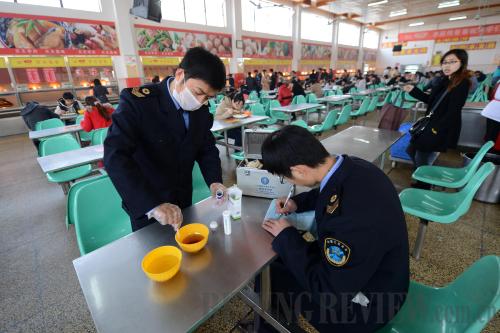|
 |
|
UNDER SCRUTINY: Food safety inspectors in Shushan District, Hefei City in Anhui Province, test the quality of edible oil used by a cafeteria in Anhui Agricultural University during a random inspection of school canteens (Zhang Duan) |
The CFDA also has also set up 10 positions for food and drug inspectors, who will be charged with the task of supervising local law enforcement on food safety.
New departments of the CFDA also include the Department of Media and Communication, the Department of Legal Affairs and the Policy Studies Office, whose duties used to be fulfilled by the Department of Policies and Regulations in the SFDA.
Local governments should take the overall responsibility for food safety of local residents, according to the State Council's restructuring plan.
The State Council issued a plan to streamline the national food safety regulatory system during the 12th Five-Year Plan period (2011-15) last July, which demands that local food safety regulators at provincial, city and county levels be equipped with standardized facilities by the end of 2015. It also emphasizes the responsibility of governments at county level and above for local food safety regulation.
Zheng Fengtian, Vice Dean of the School of Agricultural Economics and Rural Development at the Beijing-based Renmin University of China, told Economic Information Daily that local governments might ignore certain food safety risks to protect enterprises in the areas under their respective jurisdiction. For example, in a county whose economy heavily relies on its agricultural sector, government officials tend to intentionally overlook unsafe production procedures in local farm produce processing companies as most products are sold out of the county.
Pilot reforms
Since the beginning of 2010, the Chinese Government has launched three different pilot programs aimed at reforming local food safety regulatory systems in southern Guangdong Province, northwestern Shaanxi Province and northern Tianjin Municipality.
In Shenzhen and Shunde in Guangdong, the food safety authority is put under the market supervision bureau and charged with the tasks of drafting local regulations and supervising food production, circulation, catering industry and quality of edible farm produce.
In another reform in Shaanxi's Weinan City, all functions concerning food safety under government departments of agriculture, animal husbandry, quality supervision, industry and commerce administration and health have been transferred to the local food and drug bureau, which is in charge of issues involving administrative licensing, law enforcement and technical tests.
The reform in Binhai New Area in Tianjin is widely seen as the direct inspiration for the reform on food safety regulatory system at the national level. Inside sources told Economic Information Daily that the reform in Shenzhen and Shunde was deemed too timid while Weinan's model was deemed too drastic.
Zhang Tiejun, Director of Binhai's Food and Drug Bureau, said that during the reform, the regulation of catering businesses, nutritional additives, cosmetics and hygienic conditions of public venues previously under health authorities, the regulation of food production previously under quality supervision authorities and the regulation of food circulation previously under the industry and commerce administration authorities, have all been transferred to his agency. Another component of the reform is the establishment of a food product- and drugtracing system, which is used to monitor the procedures of the supply of raw materials, processing, circulation and end consumption.
Under Binhai's model, an extensive network of food and drug regulation covering all villages and urban communities has been established. Zhang said that all 27 townships and sub-districts in Binhai have a food and drug regulatory station, which employs full-time coordinators. He added that all the 351 villages and communities have a liaison office for food and drug safety issues, along with a part-time information officer. Supervisors from Zhang's bureau are stationed in every township and sub-district to ensure laws are enforced at the basic level.
While Binhai's model has proved effective during the pilot program, copying it in other places of China faces some challenges, ranging from a large number of food and drug safety personnel required, to the huge amount of money needed to set up a food-tracing system and the difficulties of monitoring food safety in the vast rural areas, according to Economic Information Daily.
Email us at: lili@bjreview.com | 